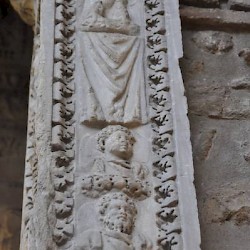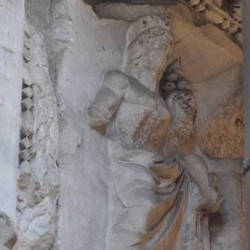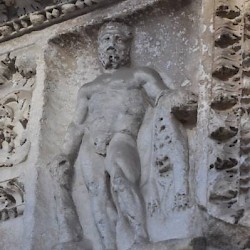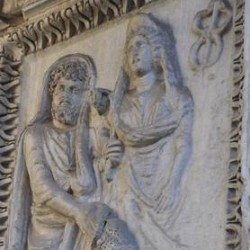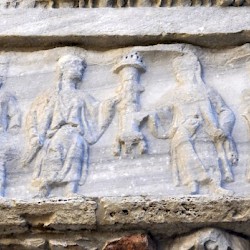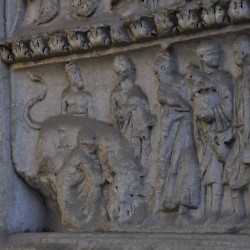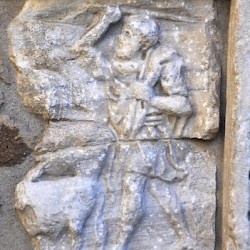Rome, Arch of the Bankers
Q645062Rome: central city of Italy, capital of the Roman Empire, largest metropole of the ancient world.

Today, the Arch of the Bankers (Arcus argentariorum) looks like a little annex to the church of San Giorgio in Velabro; in fact, the front of the church is built over the arch, as you can see on the first picture. This modest arch was built by the cattle dealers who were active on the nearby Forum Boarium ("cattle market"), and the bankers, who did their business in the Vicus Tuscus ("Etruscan street") between the Forum Boarium and the Forum Romanum.
The inscription (CIL VI.1035) on the architrave commemorates the emperor Septimius Severus (r.193-211), his wife Julia Domna, and their two sons Caracalla and Geta, and identifies the year in which the arch was erected as 204. We can be a little bit more precise about the date: it was before the fall of the praetorian prefect, Gaius Fulvius Plautianus, who is mentioned in the inscription; he was executed in the summer of 204, which suggests that the Arch of the Bankers was finished in the first half of 204. The monument may have been a belated present for the rulers' tenth year jubilee.


After the death of their father, in 211, his two sons started to quarrel, and Caracalla killed his younger brother - in the arms of their mother Julia Domna. Everywhere in Rome, the name Geta was erased from the inscriptions. His portraits were damaged too: inside the Arch of the Bankers used to be representations of both princes, but Geta has been removed. Originally, both young men were seen sacrificing, just like their parents on the opposite part of the arch.
Two other people had already fallen victim to a similar act of political vandalism: Plautianus, who was shown next to the emperor and the empress, and his daughter Plautilla, who must have stood next to Geta, facing her husband Caracalla.
The monument, which is almost six meters wide and seven meters high, consists of two hollow piles that were covered with travertine. On top of it must have stood a statue of the emperor or a deity. The decoration is extremely rich and varied; in fact, not a single part of the arch is left undecorated. Everywhere are eagles, military objects, captives, garlands and other floral motifs.
The inscription on top of the arch is flanked by two figures: Hercules survives. It is interesting. Between 180 and 192, Rome was ruled by the extravagant Commodus, who claimed to be "the Roman Hercules". After he had been assassinated, civil war broke out and Septimius Severus became emperor. Later, the new emperor claimed to have been adopted by Commodus' father, Marcus Aurelius. This made Commodus a brother of Severus, and on more than one occasion we see Hercules return in Severan propaganda.
His counterpart, a figure with a cornucopia, must be Dionysus. The two deities are also found on several monuments in Lepcis Magna, the birthplace of Septimius Severus.
